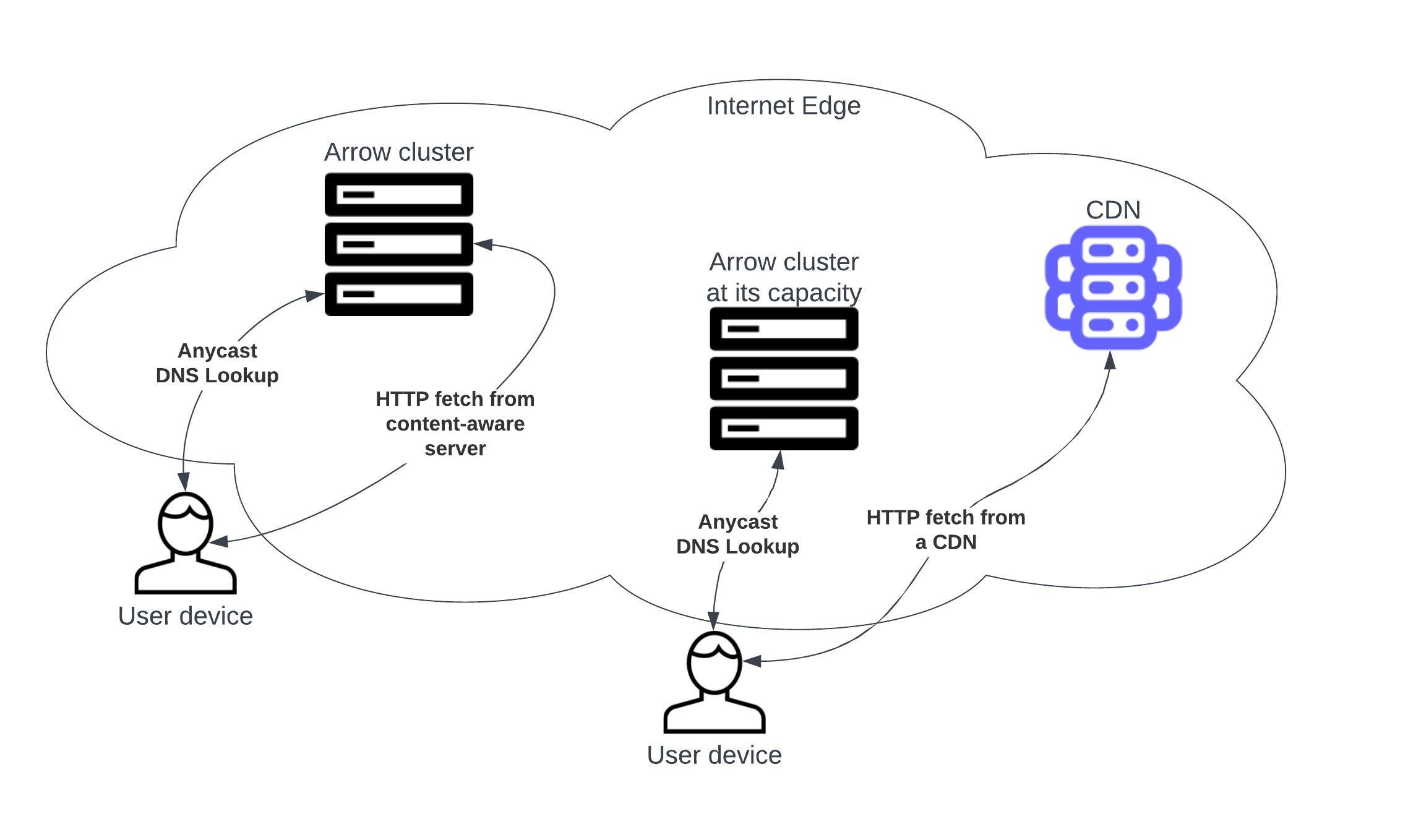Measures bitrate per user (brpu) a server, a member of a cluster, is capable to sustain real time. It allows load-balancing with a minimal brpu guarantee that can be aligned with bitrates media content is encoded at. This guarantee as a service level objective ensures uninterrupted media consumption (quality of user experience) and builds a solid basis for horizontal and vertical capacity planning (optimal distribution of infrastructure costs).
Arrow is intended to sit on top of CDN(s) and let them serve overflow traffic only. While handling all the traffic is a possibility too, without CDN being an overflow hedge bitrate per user guarantee can be violated.

This is an anti-master design pattern, wherein each node of a cluster holds complete state of the cluster and, thus, runs autonomously. Failure of any node could only impact existing connections (users) but not newcomers. Same applies to SSD storage units within a single node.
Any content delivering server is typically constrained by 1/ CPU cycles; 2/ network bandwidth; 3/ block I/O bandwidth (between RAM and a longer-term storage such as SSD). Arrow accounts for all of them. Furthermore, hardware and network architecture/revision should aim to keep the three in balance. Significant imbalance will negatively influence the total cost of ownership.
Every node (a CDN machine) adds either
There are variants in configuration of the CDN affecting performance. They rely on consistent hashing of keys pertinent to a content structure. By example, assuming a movie called "matrix":
- Request URL:
https://cdn.foo.com/assets/matrix/manifest.mpd?a=b&c - Cache key:
foo.com/assets/matrix/manifest.mpd - Cluster key:
foo.com<md5(/assets/matrix)>
Note, matrix/ folder is likely to also have the movie's chunks we want on one same node with the manifest file, the /assets/matrix part is a customer-specific regex, and the first technical label(s) of the hostname (e.g., cdn.) are omitted.
This is a well-known approach. User requests land on cluster nodes at random. When a node is not designated to cache the content, it pulls from the designated one. As such, at worst double bandwidth is taken from the cluster compared with the best case of local caching. With
Arrow manages
If you are flexible about hostname part of the URL initiating playback (such as a manifest file URL), you could construct the following request:
https://md5</assets/matrix>.cx.foo.com/assets/matrix/manifest.mpd?a=b&c
Instead of classic CNAME for cdn label, foo.com zone would have:
cx NS cx-glue.foo.com.
cx-glue A <AnycastIP1> (a cluster node)
cx-glue A <AnycastIP2> (a cluster node)
cx is an arbitrary delegation (could be cdn as well). Now the cluster can respond with a unicast address of a node having the content based on the cluster key, here, available at the DNS look-up. With this content-awareness at DNS level:
Neither traffic forwarding nor content mirroring is required.
NB Both configurations described above can run concurrently as keys stay all the same.
Arrow cluster consists of commercial off-the-shelf (COTS) hardware.
arrow package implements a service exposing a shared memory region with brpu and weight (used to quantify storage as nodes can be individually sized). The region contains a record for every node in the cluster. The records get updated by multicast comets. A stale record would signal out-of-service node that could be automatically excluded from the game.
Each node is on record by its canonical name obtained by a reverse look-up by an IP address. Therefore, either PTR record or /etc/hosts file must reflect zone's information for the whole cluster. For example, a two-nodes cluster may be known as:
n01.lax.hw.bar.net. 600 IN A 178.62.11.17
n01.lax.hw.bar.net. 600 IN AAAA 2a03:e0c0:d0::14:f001
n02.lax.hw.bar.net. 600 IN A 178.62.11.18
n02.lax.hw.bar.net. 600 IN AAAA 2a03:e0c0:d0::14:f002
Each hosts file could then contain:
178.62.11.17 n01.lax.hw.bar.net
178.62.11.18 n02.lax.hw.bar.net
2a03:e0c0:d0::14:f001 n01.lax.hw.bar.net
2a03:e0c0:d0::14:f002 n02.lax.hw.bar.net
Although it may seem redundant at a first glance, this level of indirection simplifies node-level DNS exchange - only CNAMEs are returned - and, more importantly, allows grouping nodes analogues to Akamai's serials.
In reality, we use a prefix to anycast a service, for example a CIDR /24 containing 255 IPv4 addresses. Four out of those 255 could constitute DNS glue (see above), and other 80 (for instance) could be distributed across nodes in a cluster to handle HTTP(S) requests: a cluster of 4 nodes => each node gets 20 addresses it serves, a cluster of 20 nodes => each node gets 4 addresses it is known by. This architecture would be more DoS-resilient than unicast-addressing; on the other hand, it still allows arbitrary number of nodes in a cluster.
lib package implements a shared library function that takes a cluster key and returns a corresponding in-service node along with indications of an error, overload, or self-serving. The library is used by a Lua module (part of the package) that integrates with Openresty package to do HTTP(S) part of the game.
pdns is an integration with PowerDNS via above lib package.
Consider
# curl -skD- "https://c.dx.claw.ac/assets3/matrix/manifest.mpd?a=b&c"
HTTP/1.1 200 OK
Connection: keep-alive
Server: n01.lax.hw.hyvd.net
Access-Control-Allow-Origin: *
Act >0<
Hash input_: /assets3/matrix
Cluster key: claw.acaa22fad1ed4a441d54fa664f53d5b0ee
Cache__ key: claw.ac/assets3/matrix/manifest.mpd
Pull_: http://n02.lax.hw.hyvd.net/assets3/matrix/manifest.mpd?a=b&c
This cluster nodes determine the asset should be cached at n02. Hostname of the request above is not content-aware, so its resolution flaps with a short-lived CNAME:
# dig c.dx.claw.ac
;; ANSWER SECTION:
c.dx.claw.ac. 5 IN CNAME n02.lax.hw.hyvd.net.
n02.lax.hw.hyvd.net. 3600 IN A 3.3.3.2
or
# dig c.dx.claw.ac
;; ANSWER SECTION:
c.dx.claw.ac. 5 IN CNAME n01.lax.hw.hyvd.net.
n01.lax.hw.hyvd.net. 3600 IN A 3.3.3.1
The result of the curl would stay the same regardless. With a content-aware hostname DNS resolution to n02 stays consistent:
dig aa22fad1ed4a441d54fa664f53d5b0ee.dx.claw.ac
;; ANSWER SECTION:
aa22fad1ed4a441d54fa664f53d5b0ee.dx.claw.ac. 300 IN CNAME n02.lax.hw.hyvd.net.
n02.lax.hw.hyvd.net. 3600 IN A 3.3.3.2
And n01 node wouldn't get involved whatsoever:
# curl -skD- "https://aa22fad1ed4a441d54fa664f53d5b0ee.dx.claw.ac/assets3/matrix/manifest.mpd?a=b&c"
HTTP/1.1 200 OK
Connection: keep-alive
Server: n02.lax.hw.hyvd.net
Access-Control-Allow-Origin: *
Act >1< (self-serving)
Hash input_: /assets3/matrix
Cluster key: claw.acaa22fad1ed4a441d54fa664f53d5b0ee
Cache__ key: claw.ac/assets3/matrix/manifest.mpd
Pull_: http://n02.lax.hw.hyvd.net/assets3/matrix/manifest.mpd?a=b&c